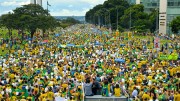It’s the kind of incident long feared since the end of apartheid in South Africa: members of the South African Police Service opened fire on striking workers at Lonmin’s Marikana platinum mine in North West province on Aug. 16, killing 34 and injuring at least 78.
Police were trying to disperse a crowd of 3,000 when apparently some strikers, armed with machetes, rocks and makeshift weapons, charged at officers, who responded with a steady stream of live fire. Harrowing footage of the shooting taken by a news agency cameraperson working alongside the police officers is readily available online.
South African President Jacob Zuma said he was “saddened and dismayed” by the tragic events, and the next day established an official Commission of Inquiry into the incident.
The terms of the inquiry have not yet been announced, but they must take into account wider issues endemic to the brutalized world of large-scale underground mining in South Africa, in particular why normal channels for addressing workers’ rights and wage issues have clearly broken down.
South Africa’s Independent Police Investigative Directorate will carry out a parallel inquiry, probably sticking more to the issue of whether the police used lethal force that was justified and proportionate. It’s too early to tell if this was the case or not.
Lonmin put out a statement expressing condolences to the families and friends of all the employees who lost their lives on Aug. 16, as well as in the days before the shooting — eight Lonmin employees and two police officers had been killed in the first six days of violent striking before the ultimate confrontation. The company said it would establish an education fund for the children of those killed, and would assist with funerals.
Days after the shooting, the company reiterated its ultimatum that workers return to work or be fired, but by Aug. 20 only a third of the mine’s 28,000 workers had showed up. Lomin stated that the mine was open again, but that operations were limited because of the lack of employees.
As of press time politicians and some trade unions were calling on Lonmin to abandon its previous threat to fire workers who would not arrive to work on Aug. 21.
Before the shooting, Lonmin had given an ultimatum that workers return by Aug. 17 or be fired. Early that day Lonmin had stated that the situation at Marikana was relatively quiet but tense. The company had also welcomed the increased presence of South African police to deal with what it has framed mostly as a struggle between rival unions — not a strike about pay or working conditions.
The well-established National Union of Mineworkers (NUM) has been fighting with the newly formed Association of Mineworkers and Construction Union (AMCU) for the support of workers, with the AMCU far more aggressive in its wage- and working-condition demands. AMCU workers have been asking for a pay raise of roughly $1,000 a month to add to the $480 to $600 a month they are currently making.
On the same day as the shooting, Lonmin announced that its CEO Ian Farmer has been “diagnosed with a serious illness,” and that the executive committee, led by Roger Phillimore, would temporarily take over.
In the six days of striking leading up to Aug. 16, Lonmin had lost 15,000 oz. platinum production from Marikana, which ranks as the world’s third-largest platinum mine, and has warned that it will likely not meet its 750,000 oz. target for the year. The company also gave notice that it expects costs per ounce will go up beyond the 8.5% increase already projected.
Earlier this year Impala Platinum was hit with a six-week strike at its Rustenburg platinum operation in South Africa, the world’s largest platinum mine. During the strike at least three people were killed. The conflict at Rustenburg was similarly stirred by higher wage demands and feuding between the NUM and the AMCU.
Lonmin’s share price dropped 56.6 pence, or 8.1% over two days, to close at 640.2 pence the day after the shooting, making for a 17.3% drop from the 774 pence it closed at on Aug. 7 shortly before the strike started.
The price of platinum rose 6.3%, or US$88 to US$1,481 per oz. on the news by Aug. 20, its highest level in over a month.



Be the first to comment on "Editorial: SA police fire on Lonmin strikers"